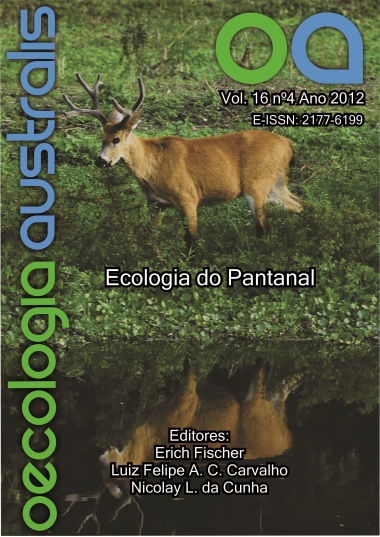DIATOMS FROM SHALLOW LAKES IN THE PANTANAL OF NHECOLÂNDIA, BRAZILIAN WETLAND
Keywords:
biodiversity, brackish water, freshwater, tropical wetland.Abstract
The diatom flora of the shallow lakes in the Pantanal of Nhecolândia is poorly known. Thus, our aim was to know the diatom biodiversity in three types of shallow lakes called “baías, salitradas and salinas”, characterized by differences in pH, electrical conductivity, contact with the coalescent system and the presence of macrophytes. The samples were collected in dry and rainy seasons, from 2004 to 2007. For taxonomic identification, the material was cleaned with H2O2 and analyzed using light microscopy. A total of 23 diatom species were identified and each lake presented a unique species richness and composition. The greatest species richness was found in the Baía da Sede Nhumirim (21 species), followed by the Salitrada Campo Dora (8 species) and finally the lowest species richness was observed in the Salina do Meio (3 species). Only Anomoeoneis sphaerophora Pfitzer var. sphaerophora and Craticula cf.buderi(Hustedt) Lange-Bertalot occurred in the three studied systems. Except for Eunotia binularis (Ehrenberg) Souza and Aulacoseira ambigua (Grunow) Simonsen, all the others are new records to the Brazilian Pantanal.
Downloads
Downloads
Additional Files
- camiladebarros, OA_Santos_Rocha_&_SantAnna_DIATOMS.doc (Português (Brasil))
- camiladebarros, OA_Santos_Rocha_&_SantAnna_diatoms_figure1.a-h.jpg (Português (Brasil))
- camiladebarros, OA_Santos_Rocha_&_SantAnna_diatoms_figure2.a-j.jpg (Português (Brasil))
- camiladebarros, OA_Santos_Rocha_&_SantAnna_diatoms_figure3.a-k.jpg (Português (Brasil))
- camiladebarros, OA_Santos_Rocha_&_SantAnna_diatoms_figure4.a-l.jpg (Português (Brasil))
- camiladebarros, Sugestão de possÃveis revisores DIATOMS.doc (Português (Brasil))
- camiladebarros, CARTA DE SUBMISSÃO DIATOMS.pdf (Português (Brasil))


